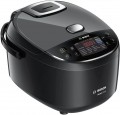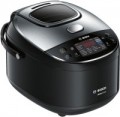Functions
—
Thermostat. The multicooker features a temperature control regulator that allows users to set specific temperature values for the cooking container. Once the desired temperature is set, the device autonomously adjusts its operating mode to maintain a constant temperature throughout the cooking process. This function can be utilized independently or in conjunction with automatic cooking programs, providing flexibility and precision in temperature control for various cooking needs.
—
Induction heating. Induction heating operates by using magnetic induction to heat the bottom of the cooking vessel. This unique method enables the working surface of the dish to reach the desired temperature within seconds. Additionally, the absence of a conventional heating element contributes to the energy efficiency of induction-based multicookers. Such models can achieve efficiency rates of 95-98%, leading to more effective energy utilization during the cooking process.
—
3D heating. The "volumetric heating" technology in multicookers incorporates additional heating elements, typically located in the lid. Another option for its implementation is the presence of a built-in fan on the inside of the lid to ensure the circulation of heated air flows. Thanks to this, the food is heated both from below and from above, which allows you to significantly speed up the cooking pr
...ocess, as well as achieve maximum uniform heating. Also, 3D heating allows you to increase the number of cooking programs used.
— Auto-cooking. The presence in the device of programs for the automatic cooking of various dishes. Using such programs is often more convenient than adjusting all the parameters manually; see "Programs" above for details.
— Temperature maintaining. In the keep warm mode, the multicooker does not turn off immediately after the end of the cooking programme, but continues to operate at a low power setting, maintaining a warm temperature to keep the cooked dish hot and ready to serve.
— Auto-off timer. This function enables users to set a specific time for the multicooker to automatically turn off. This eliminates the need to manually track the cooking time, reducing the risk of overcooking or spoiling the dish. Auto-off functionality is typically available in multicooker models with auto-cooking capabilities, as mentioned earlier. However, it can also be found as a separate feature in simpler models, offering convenience and peace of mind during the cooking process.
— Delay start timer. The multicooker's programmable start function allows users to set a specific time for a cooking program to begin automatically. This feature offers the convenience of preparing dishes, such as freshly cooked porridge, for breakfast without needing to be present in the kitchen. By loading the ingredients into the multicooker the night before and setting the timer for the desired morning time, users can enjoy the luxury of sleeping a bit longer in the morning without having to manually start the multicooker.
— Remote control. The multicooker offers the convenience of remote control, typically facilitated through a dedicated application installed on a smartphone, tablet, or other compatible devices. With this feature, users can control the functions of the multicooker from a distance. In some models, this remote control capability extends to controlling the multicooker via the Internet, allowing users to manage it from anywhere in the world. The remote control feature is not only convenient for adjusting settings remotely, but also because the accompanying mobile applications often provide extensive functionality beyond what is available on the standard multicooker panel.
- Child protection. child protection in this case means the ability to lock the multicooker control panel - so that a curious small child cannot turn on the device or change the operating settings. However, for an adult, removing the lock is not a problem. Ideally, this function should be combined with a reliable lock on the lid, however, child protection alone does not guarantee the presence of such a lock - it would not hurt to clarify this point separately.Non-stick coating
The type of non-stick coating used in the working container of the multicooker.
—
Teflon. Teflon, also known as polytetrafluoroethylene (PTFE), is a widely used non-stick coating characterized by its dark color. It offers excellent non-stick properties and is easy to clean, making it popular in various applications. However, there are specific guidelines for using Teflon. Overheating should be avoided as it can cause cracks and the release of harmful substances. Although the maximum operating temperature of Teflon is sufficient for frying, it is not extremely high. Scratches can render the coating unusable and can also lead to the release of harmful substances, so Teflon should be washed carefully, and only wooden or silicone spatulas should be used, avoiding metal utensils.
—
Ceramic. Ceramic coating offers a combination of safety and reliability. It is resistant to scratches and remains usable even if scratches occur, without releasing any harmful substances. Similarly, ceramic coatings can withstand high temperatures without deteriorating or emitting harmful fumes. Cleaning ceramic-coated containers is relatively easy and straightforward. However, it's worth noting that ceramic coatings are more sensitive to shocks and temperature changes, which can lead to cracking or even chipping of the coating.
Control
The type of control provided in the multicooker. Note that this parameter only describes the design of external controls; there is no correlation between the type of control and the functionality of the multicooker. The options could be:
—
Rotary knobs. The multicooker is operated using distinctive rotary knobs as its main controls. These knobs can be accompanied by buttons or touch sensors, although in some models, they are the sole means of control. Rotary switches are particularly useful when multiple options or settings are associated with a single switch, such as a dozen cooking programs or temperature adjustments. However, due to their larger size compared to buttons or sensors, rotary knobs have become less common in modern multicooker designs.
—
Push-buttons. Control with traditional buttons is a popular and convenient option in modern multicookers. These button controls are cost-effective compared to touch sensors. One minor drawback of this design is that dirt can accumulate in the corners between the buttons and the multicooker body, making it slightly challenging to clean. However, this drawback is not considered critical. Overall, buttons remain the most popular control choice across various price ranges in contemporary multicookers.
—
Touch. Control with sensors offers a user-friendly experience as they do not require pressin
...g, only a light touch is needed. This makes them more convenient compared to push-button controls. Additionally, sensor control panels have a sleek design without protruding parts, making them effortless to clean. However, the main drawback of sensor controls is their higher cost compared to buttons. As a result, sensor controls are less commonly found and are primarily used in mid-range and high-end multicooker models.
In addition to these controls, some models may also offer smartphone remote control (see Features).
